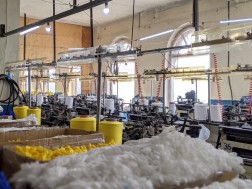Less than half of working age women in Armenia participate in the labor force mainly due to caregiving responsibilities for children and disabled family members. Those who do earn on average, from 25 to 30 percent less than their male counterparts engaged in the same work, according to a new report released today by the World Bank.
The "Armenia Country Gender Assessment" also found that women’s low level of participation in the labor market comes despite the fact that 68% of women are pursuing tertiary education, compared to 52% of men, and proposes actionable policy recommendations to drive systemic change.
“Armenia is foregoing important growth dividends by not encouraging more women to join the labor force”, said Carolin Geginat, World Bank Country Manager for Armenia. “Achieving gender parity in labor force participation alone could increase Armenia’s level of GDP by 4 to 6%. Ensuring equal wages should be an essential part of a strategy that encourages women to enter the workforce. Today, women are paid only around 70% of the hourly wage paid to a man in the same occupation.”
The report also highlights that men's enrollment in higher education remains stagnant at around 44% (in contrast to 65% for women). Men are also affected by higher mortality. Despite potential economic gains from women’s participation in decision-making roles, women are still underrepresented, including in roles such as ministers, deputy ministers, and community heads. While women currently make up 35.5% of the National Assembly, still only 17% among ministers and 18% of deputy ministers are women.
Considering the higher educational achievements of women, labor market trends for women are likely influenced by social beliefs around gender roles rather than actual skills. Although the share of women in science, technology, engineering and mathematics (STEM) fields has grown over time, women are still concentrated in traditionally lower-paid sectors such as education and social work, while men dominate fields like engineering and technology,
The report also highlights that gender-based violence persists as a serious and underreported issue in Armenia. For example, 18% of ever partnered women aged 15-59 suffered from domestic violence in their lifetime.
“The Armenia Country Gender Assessment offers the latest evidence on gender gap”, said Natsuko Kiso Nozaki, World Bank Economist, lead author of the report. “It also puts forward policy recommendations that can help to close remaining gender gaps in Armenia such as addressing social norms, bridging gaps in the legal framework and policy implementation.”
Increasing the number of women in the workforce would require promoting a more equitable sharing of caregiving responsibilities and encouraging men to take on these roles. Effective interventions include:
- raising awareness among men and women about the benefits of women’s employment
- offering adequate parental leave
- providing incentives for fathers to engage in childcare
- improving access to and use of childcare services, and
- offering vocational training, especially in sectors where women have been traditionally underrepresented.
Achieving gender parity in educational choices and employment would require:
- encouraging men to recognize the value of higher education for better opportunities
- encouraging women to pursue STEM fields at school, and
- increasing accessibility and relevance of training to equip girls and boys for a smooth transition from school to work
- mandating equal remuneration for work of equal value may also help address the gender wage gap.
Promoting women in leadership roles would require:
- implementing gender-sensitive education
- investing in training and development of female talent, and
- using role models to inspire women and gain community support.
The World Bank Group is committed to accelerating gender equality through its projects and programs under the framework of the recently launched World Bank Gender Strategy 2024 - 2030.
















